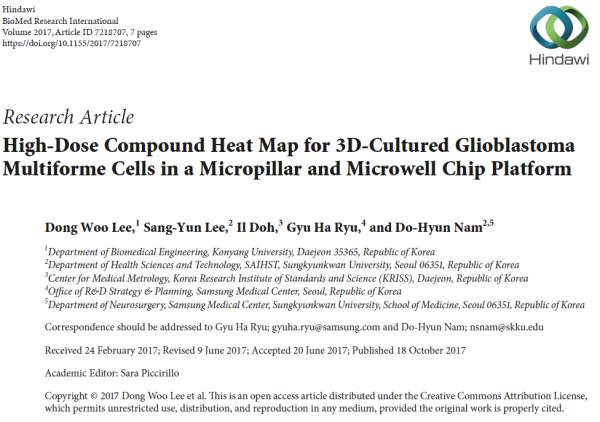Paper 2017, BioMed Research International, High-Dose Compound Heat Map for 3…
Page Info

Contents
Abstract
Glioblastoma multiforme (GBM) is recognized as the most common and lethal form of central nervous system cancer. To cure GBM patients, many target-specific chemotherapeutic agents have been developing. However, 2D monolayer cell-based toxicity and efficacy tests did not efficiently screen agents due to the pool reflection of in vivo microenvironments (cell-to-cell and cell-to-extracellular matrix interaction). In this study, we used a 3D cell-based, high-throughput screening method reflecting the microenvironments using a micropillar and microwell chip platform to draw a high-dose heat map of the cytotoxicity and efficacy of 70 compounds, with two DMSO controls. Moreover, the high-dose heat map model compared the responses of four 3D-cultured patient-derived GBM cells and astrocytes to high dosages of compounds with respect to efficacy and cytotoxicity, respectively, to discern the most efficacious drug for GBM. Among the 70 compounds tested, cediranib (a potent inhibitor of vascular endothelial growth factor (VEGF) receptor tyrosine kinases) exhibited the lowest cytotoxicity to astrocytes and high efficacy to GBM cells in a high-dose heat map model.
Glioblastoma multiforme (GBM) is recognized as the most common and lethal form of central nervous system cancer. To cure GBM patients, many target-specific chemotherapeutic agents have been developing. However, 2D monolayer cell-based toxicity and efficacy tests did not efficiently screen agents due to the pool reflection of in vivo microenvironments (cell-to-cell and cell-to-extracellular matrix interaction). In this study, we used a 3D cell-based, high-throughput screening method reflecting the microenvironments using a micropillar and microwell chip platform to draw a high-dose heat map of the cytotoxicity and efficacy of 70 compounds, with two DMSO controls. Moreover, the high-dose heat map model compared the responses of four 3D-cultured patient-derived GBM cells and astrocytes to high dosages of compounds with respect to efficacy and cytotoxicity, respectively, to discern the most efficacious drug for GBM. Among the 70 compounds tested, cediranib (a potent inhibitor of vascular endothelial growth factor (VEGF) receptor tyrosine kinases) exhibited the lowest cytotoxicity to astrocytes and high efficacy to GBM cells in a high-dose heat map model.
Related Links
- Prev
 2017, SLAS Discovery, High-Throughput Clonogenic Analysis of 3D-Cultured Patient-Derived Cells with a Micropillar and Microwell Chip 20.05.27
2017, SLAS Discovery, High-Throughput Clonogenic Analysis of 3D-Cultured Patient-Derived Cells with a Micropillar and Microwell Chip 20.05.27 - Next
 2017, Archives of Toxicology, Prediction of metabolism-induced hepatotoxicity on three-dimensional hepatic cell culture and enzyme microarrays 20.05.27
2017, Archives of Toxicology, Prediction of metabolism-induced hepatotoxicity on three-dimensional hepatic cell culture and enzyme microarrays 20.05.27

